A black draped figure seemingly glided to the front of the classroom and began scribbling on the chalkboard.
Professor Snide spoke without turning.
“Turn to page twelve-thousand, six hundred, and seventy-four and begin reading the rubric at the end of the third paragraph; subsection two, heading four, chapter eight hundred eighty-two. . .” Pausing he added “. . . aloud. . . in four part harmony. “
Wes Rongley peeped his bright orange tufted head above the antique leathern tome on the desk in front of him and peered at the board. He squinted.
To his growing horror, he could clearly make out in the ever-growing scrawl that flowed unceasingly onto the slate from the chalk in Snide’s hand integers, operators, exponents, and not a few letters of Greek.
He shuddered. He had inexplicably stumbled into a maths class.
Wes slunk back down behind the ponderous mouldering volume and wracked his hazy brain for some memory of how this could have happened. The first few days here at Hogwash’s had been a heady blur, but surely he could not have made such a colossal blunder.
There was nothing for it but to try and escape.
He slid further down in the seat, as if he could melt into liquid form and seep quietly out under the classroom’s big oaken door. He tested the floor board with the slightest pressure of his left toe.
It creaked.
“Going somewhere, Mr. Rongley?”
Caught in the act, betrayed by the ancient timber, he had little choice but to respond to Snide’s withering gaze.
“I. . .uh. . .I’m in the wrong room, sir. I don’t think I’m supposed to be in this class.”
Snide inspected the desktop and at length drew out a square of browning parchment.
“You are Wes Rongley, First Year?”
“Yes sir.”
“Then you are on my list and you are in the right room.”
The room seemed to dim when Snide had said ‘my list’. Wes felt every follicle of his flaming shock of hair contract. Perspiration formed on his upper lip. On his tightening scalp. beads of sweat began to coalesce into rivulets that ran down the nape of his neck. He ventured.
“But . . .sir . . . that looks like maths. . .”
Snide turned, his expression softening . . .which for some reason was more disturbing.
“Hmmm. . .really? Are you sure?”
Wes nodded meekly. Professor Snide leaned a bit back and regarded the unfinished equation he’d been scribbling.
“By, Jove, Mr. Rongley, you’re right! It is maths! Seen them before, have you?”
“Yes. . .yes, sir!”
“Well, now you’ve seen them again. Turn to page twelve thousa-“
“I was told there’d be no maths, sir.”
“What?”
“I was told there wouldn’t be any maths. When I signed up, sir. That old chap, Humblebore was it? He said that maths weren’t required for my programme.”
“Headmaster Mumblesnore,” Snide corrected, “may have been a tad vague on this point. Let me assure you, Mr. Rongley, maths are indeed required.”
Wes felt Snide’s dark presence swirling toward him down the aisle but couldn’t move. He was a mouse transfixed by a great black cobra, knowing doom was coming but powerless to escape.
“How else do you expect to tease out the subtler courses of the orbs on their wanderings through the heavens, or divine the sublime secrets of the Gematria, or calculate allowed deductions for consumable spell components and the depreciation of cauldrons of more than a hogshead’s capacity when filing with the Inland Revenue?
‘Let there be no doubt in your mind, Mr. Rongley. Maths. Are. Required.”
Satisfied, Snide turned and had made it halfway back toward the front when Wes exploded:
“But I don’t like maths!”
Snide whirled. There was a flash and puff of sulfurous vapor.
There, atop the vast ancient folio, in the middle of an unwholesome looking greasy spot, sat a rather confused looking amphibian with a shock of flaming orange hair.
-Excerpted Unabridged from Hairy Plodder and the Half-Done Script
Like young Mr. Rongley, I too, did not care for ‘maths’ as it is commonly styled in Britain. Seeking a similar avoidance of all things mathematical, I pursued a career in the creative arts.
It is one of life’s little ironies, that when my own term at the Hogwash School of Wizardry, Witchcraft, and Computer Repair was over, that I entered a field where mathematical calculations are both necessary and intensive.
In further evidence of the universe’s perverse sense of humor, my personal occult studies are repleat with examples of the necessity of mathematics, algebra, geometry and trigonometry, and yes, calculus.
Having avoided many of these courses in school it fell upon me to educate myself over the years as required. The result is that I perhaps have not approached the topics in the same staid way that they are typically taught, and though I do get the needed accuracy of result, my methods are more in tune with the way my left-handed right-brained operations work.
I feel confident that, insofar as I am not building a nuclear reactor in close proximity to inhabited areas, said methods are sufficient for my goals. I’m sharing a bit of them this week in order to acquaint you with the delight I often find now in working with purity of numbers and the permutations thereof.
In a previous article I have spoken about the absolute reality of number itself. That is, number is a real immutable infinite and eternal thing, which remains fixed regardless of time, space, velocity, or dimension. One is always one. Two is always two. One and two are and have been and will always be three. Whether we call that three or tre or trois or drei is irrelevant, the actual thing that it is never changes.
There’s a comfort to that. It’s nice to know that regardless of how much chaos swirls around us there’s still something that remains unchanged. It is the Anchor in the Sea of the Night. It is a Fulcrum in the Void. It is a Beacon on the Shores of Infinity.
Of course, sometimes, it’s fun just to play around and see what comes up. My subject for today is the hexagon, a regular geometric shape having six equal sides.
While the word hexagon doesn’t have a connection with our use of the word hex in occult circles, the doctrines of sympathy and correspondence would argue otherwise. Hex in witchcraft comes at us out of Old German and Old Norse, and probably shortens and corrupts from hagatesse – a word used to refer to the Norns, the old women who sat at the base of the World Ash Ygdrassil and pronounced the fates of man. The connection between Norn and witch is an easy one, and the term haxa and haxxen have been used to apply to witches since early times in various north and central European dialects. Thus it crossed the Channel with Hengst and entered into the Anglo-Saxon tree.
The hex in hexagon, though, is ancient Greek for six, and merely means it’s six sided, or six angled, and there’s no magical connotation at all.
Except that there is. And frequently this confutation between the witchy hex and the mathematical hex is expressed in the darnedest of places.
For instance, among the “hex signs” of the so-called Pennsylvania Dutch. The Dutch are more accurately Deutsch – Germans, who settled in Penn’s Woods along with other emigrees seeking arable land and the ability to worship openly. They are noted – among other things, for the curious geometric designs that grace barns and some houses, which are said to drive away the “devil” and other malicious spirits. In this case the “hex” is the old German haxxan – a specifically magic application. Yet many of these geometries are based on six sided figures, though perhaps as many, if not more are eight-sided.
The hexagon is the natural regular shape that is formed if you outline from point to point on a hexagram. Now the hexagram is an established magical and talismanic shape, known as the Star of David, Solomon’s Seal, and other specific names. It is the figure below, which is composed of two overlapping triangles, and as you can see, it fits neatly into the hexagon.
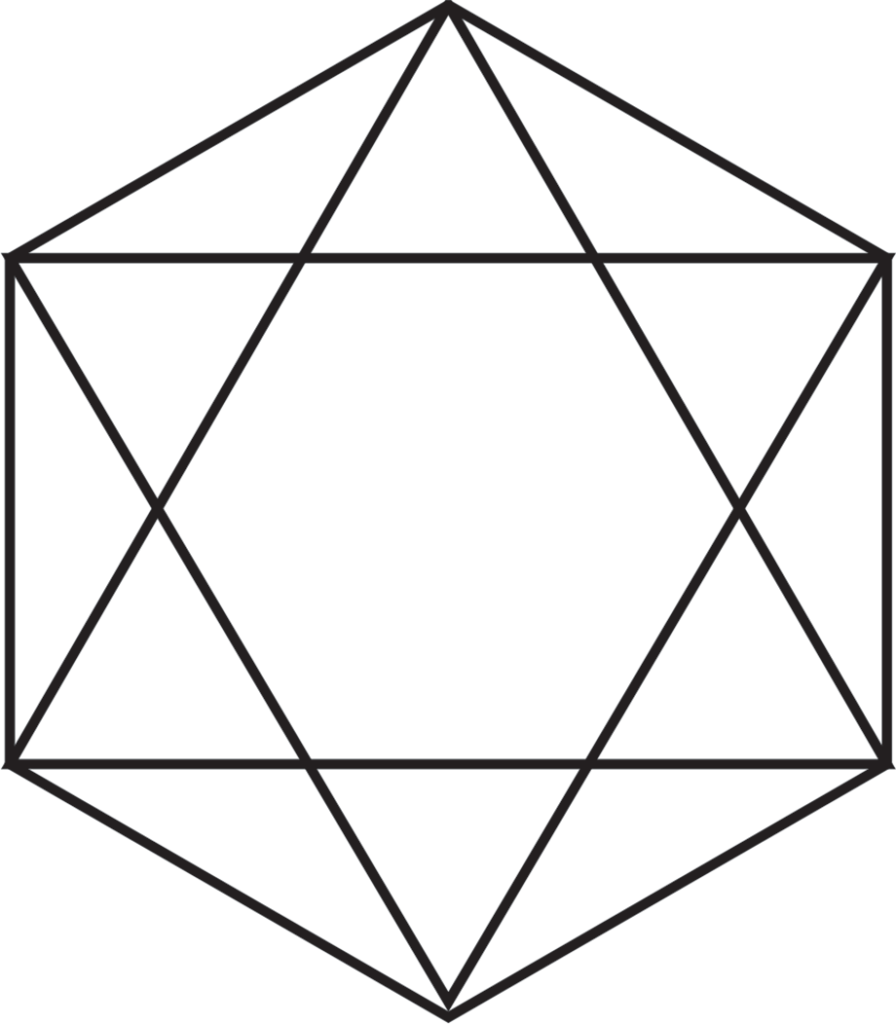
In the parlance of the occult, this image has many meanings. The following image comes from Eliphas Levi’s Histoire de la magie and demonstrates the maxim supposedly extracted from the Emerald Tablet penned by no less a personage than Hermes Trismegistus himself. It is “As Above, So Below”
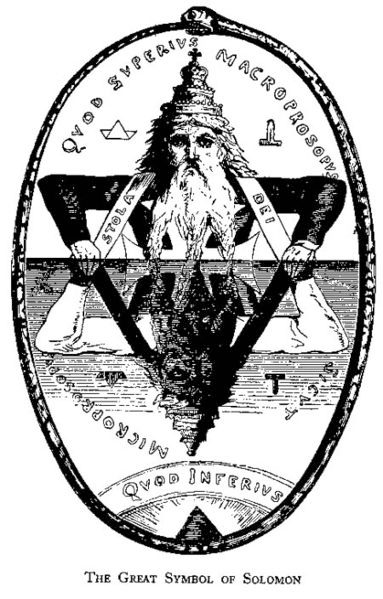
The actual text,
That which is above is from that which is below, and that which is below is from that which is above
translated into English from Latin or Arabic, which was probably translated from Greek, essentially says that all things in nature are aspects of a single cohesive whole.
From the standpoint of Greek philosophers laboring in Alexandria, this might be a convenient expression for the atomos proposed by Democritus in 400 B.C.E. and a forerunner of our idea of the atom.
Thrown into the rather more fanciful environs of medieval Europe, accompanied on it’s way with tales of djinns and efrits and the glorious magics of Solomon the Wise, the idea became a binder between the heavens and the earth, and justification for the correspondences of metals, stones, plants, and the like with the natures and virtues of the planetary wanderers.
And yet in this aspect was the roots of modern medicine, metallurgy, and chemistry, as well as enduring metaphor for the expansion of the consciousness. Alchemists revered this phrase and it’s interlocking trines throughout their search for the Elixir of Life and Philosopher’s Stone. It carries within it even more secrets, hinted at in the texts of the Emerald Tablet.
Its father is the Sun and its mother the Moon.
The Earth carried it in her belly, and the Wind nourished it in her belly,
as Earth which shall become Fire.
Feed the Earth from that which is subtle
Here then are references to at least three of the four classical elements – Earth, Wind, and Fire. This kind of phrase, along with the most imaginative of illustrations, form the rhebus instructions of the alchemical manuals. But I think the really neat trick is how we find the elements with our hexagon/hexagram.
First, of course, we just have to separate the “Above” from the “Below” and we get Fire and Water. But look more closely at the joined triangles. If you take the upward pointing triangle and the bottom line from the downward pointing triangle, you get the sign for Air. Flipping that to the downward pointing triangle gives us Earth. So the four elements are hidden figures within the As Above, So Below hexagram.

But, like any good late night infomercial pitch, that’s not all. The hexagon/hexagram combination does that same nifty trick that the pentagon/pentagram does. Within the hexagram inside the hexagon is another hexagon. You can then create another hexagram in that, which creates another hexagon inside it, ad infinitum.

Welcome, my friends, to the concept of fractals. And also the basic ideas that lead us into the murky waters of quantum theory – no matter how small something is, it’s always made up of something smaller. And, well, no matter how big something is, there’s probably something even bigger outside it, that maybe you don’t see until you get outside that, and outside that, and outside that…
So again, turtles all the way down. Most of which have no connection to Renaissance artists or togakure-ryu. But if it helps, you can think of all those repeating hexagon/hexagrams as being diagrams of turtle shells.
If infinity has you’re head spinning, let’s jump back onto a more solid ground. Platonically solid ground, in this case, as a few choice lines from the angles in the hex give us a nice diagram for the first two platonic solids, the pyramid, and the cube. From two dimensions we have moved into three, or at least we are representing three dimensions in a two dimensional space, and that’s nifty in itself. The cube is more elegantly expressed of course, because in addition to just looking better, we have the added symbolic link of a six-sided object being used to represent a six-faced object. I’ve tried to find some sacred number related to the four faces and six sides, but it’s not there, so it’s just that you can draw it if you need to, though again it’s not as isometrically clean.
On the other hand, if you wanted to get a four faced pyramid (which is actually five sided; four triangles and a square) you just have to modify that upward pointing triangle and the square of the cube. It’s not exact to the one’s that the Egyptians built, mind you, and I make no claim that it has any relation to them. I think I will probably due a future article on the legend, myth, and symbology associated with pyramid structures in human history, but that’s not for today. In the meantime, it’s a satisfying exercise.
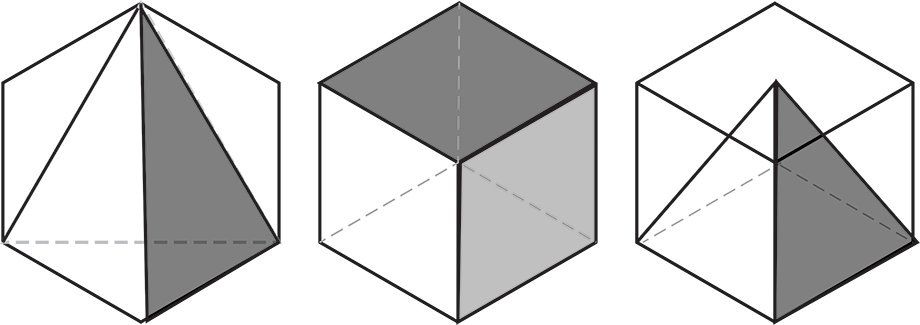
Of course, one of the most basic ideagrams that we can render from the hexagon shape is the “hex” itself, as six-rayed assembly of lines. This equivocates to the “grove” symbol in the Ogham script. Again, I can’t say there’s any evidence of a connection, but that doesn’t prevent you making one, and drawing on the power of that symbol. In some permutations of the Ogham grove I have found it also flexes to represent the transits of the luminaries on the equinoxes and solstices. That is, if you take an aerial view of Stonehenge – or the Great Pyramid of Giza for that matter – and plot the sunrise and sunset positions of the sun and moon on the equinoxes and solstices, you get a hex line shape. In this case, the angles are much more shallow, as the Tropic are around 23.7 degrees north and south of the equinoctal line, and in a regular hexagon, the angles are 60 degrees.
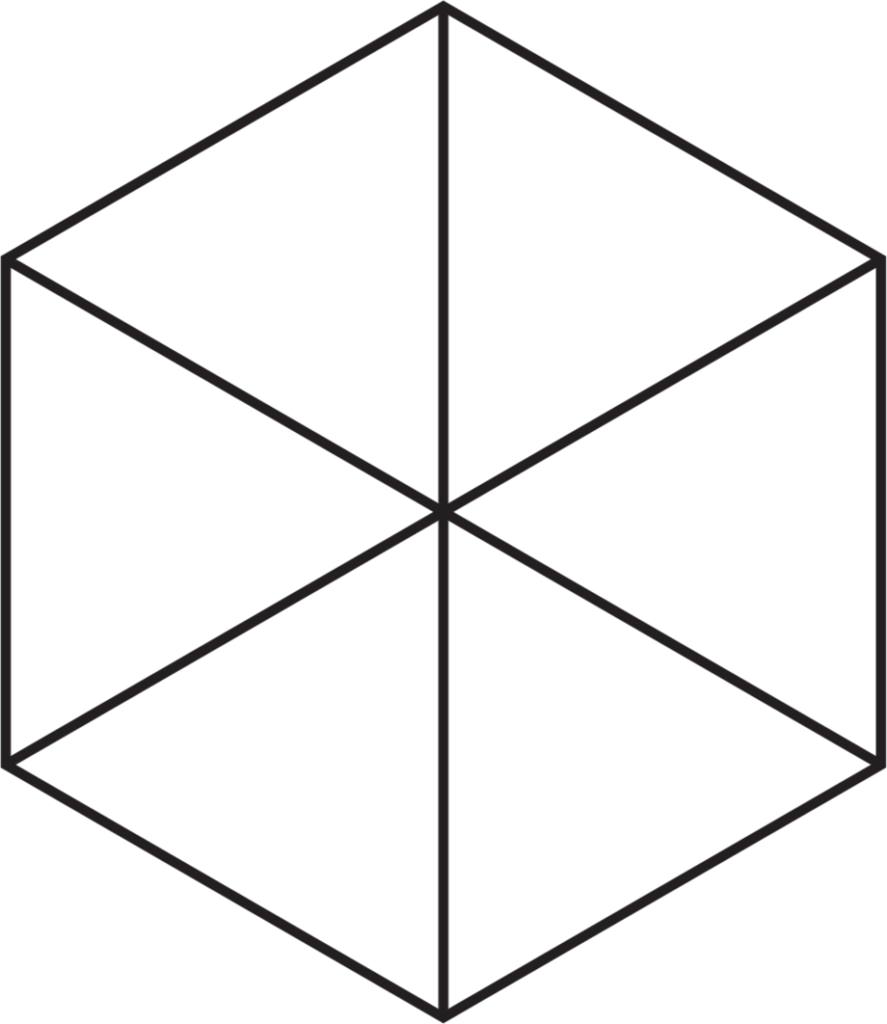
Which is to say, they are sextile for the purposes of astrology. Which we can also derive from the hexagon shape. For instance, if we take one of our inner triangles, and draw a line from each corner to the middle (instead of all the way across) we get a three rayed shape with angles of 120 degrees. This is a trine. you can also achieve the same design by erasing half of the rays in the hex. Have of six is three. Half of sextile is trine, even though the angle measurements double. I always had trouble understanding that relationship until I started playing with these hex diagrams. Maybe this will help you.
You can find the 90 degrees of a square aspect with a hair more work. Put the hexagram back in and draw a line from the top of the upper triangle to the bottom of the bottom triangle. Now draw a line across the point where the two triangles join in the middle. Erase the extra lines and viola – a four rayed shape with 90 degree angles.
You have now derived the three major aspects used in astrology. Of course, you’re going to need a chart.
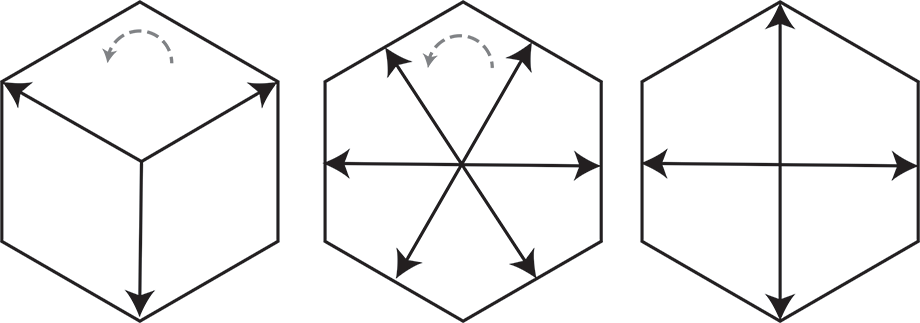
So take the hexagram, and draw lines through each point of the triangle, like we do to get the hex, and then draw lines through each of the intersecting angles, like we did to get the square. You end up with 12 rays, and the cusps of 12 signs. In the diagram I’ve reduced the size of the hexagram, so the relationship is clearer, but you can see it does indeed contain the keys to a zodiac.
Overlaid in color here are two of the trine diagrams, one in blue, which shows you the relationships of the water signs. You can rotate this to locate the air, earth, and fire signs, respectively. The red one also shows the locations of the cardinal, fixed, and mutable triplicity, in this case for the signs of fire, but just rotate it around and the others fall into place.
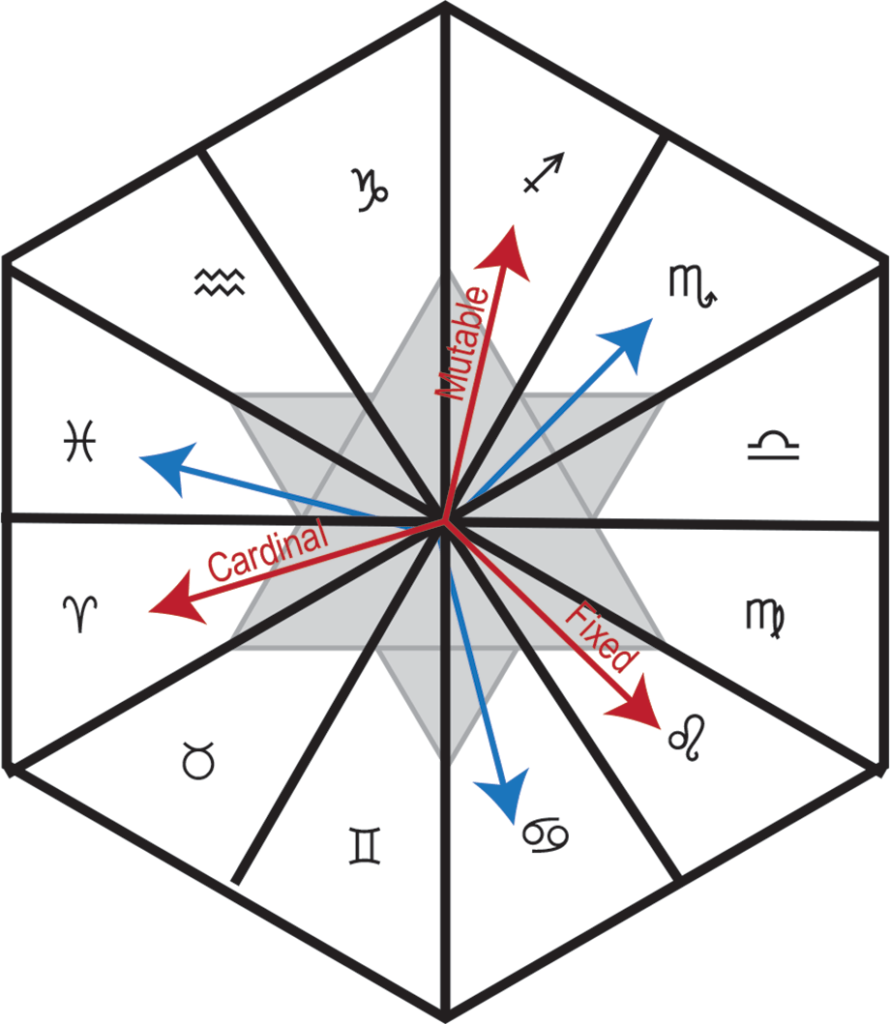
Is this all that we can tease out of the humble hexagon? No. Fiddling around in my art software I was able to come across a few more totally unrelated, but poignant connections using just the geometry and some imagination.
Taking our hex lines again, you can look to them as Cartesian coordinates. They are the X, Y and Z axes of three dimensional space. Anyone who struggles with that train leaving Chicago problem may remember some of these exercises from algebra classes. I do a lot of 3-D animation work, and the 3-D grid is almost second nature to me. Essentially the center where the three line cross is 0, and any point in space can be plotted using positive or negative values along those lines, so X is left and right, Y is up and down, and Z is forward or back. In order to see clearly the values of all three lines, the diagram is usually tilted in almost exactly the same way as our hex. So you can use a hex to put anything anywhere.
Now, I have mentioned before that we all live in a four-dimensional space-time. If I want to diagram it on my hexagon, I can just drop it in at a right angle to Y axis, and get the following figure.
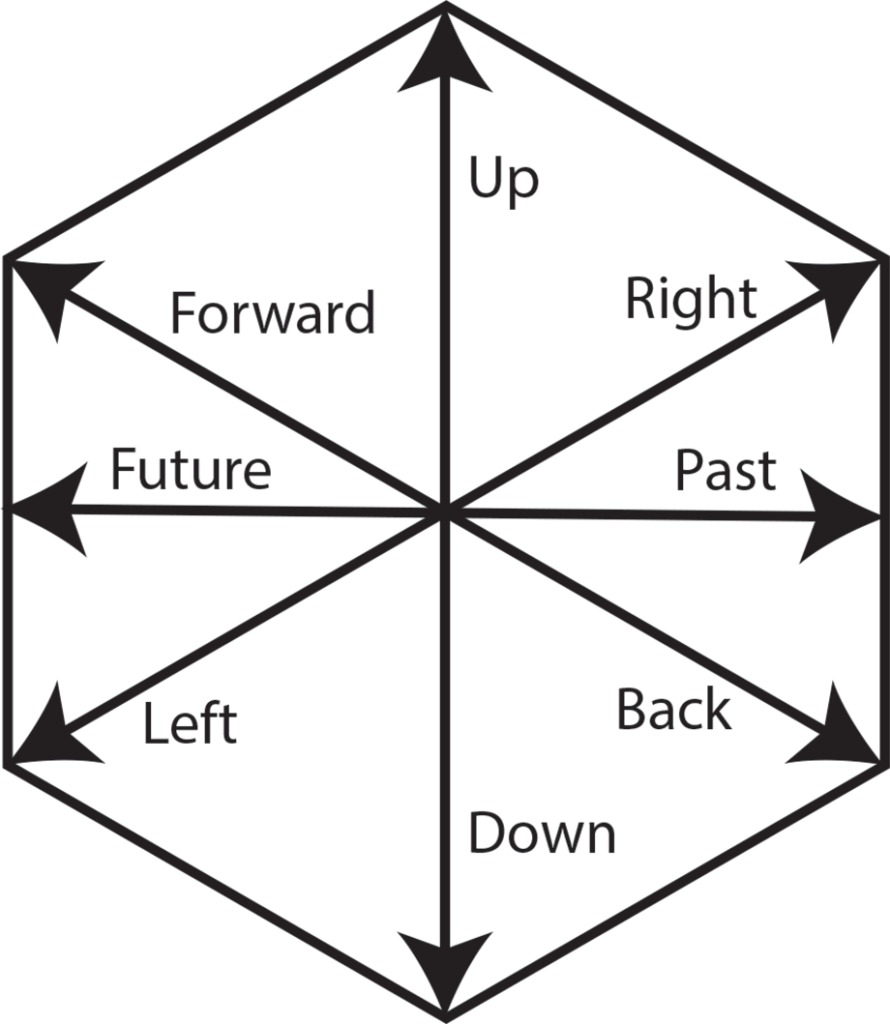
So any point in space and time can be reached by virtue of the hex. That might explain why the capacious interior of a certain blue phone box has had hexagon wall decorations for several decades. Or not. Still, it’s an intriguing expression of the concept.
Moving back into more esoteric spaces, I was also able to take the basic hex, add a few curves, and arrive at the Xi-Rho symbol, usually with Alpha and Omega, this is supposedly the vision of Constantine at the Malvern Bridge, with motto “in hoc signio vincis” – In this Sign, you will Conquer. While historians generally believe that Constantine took it as a message from Sol Invictus, later Christian records give it as the Xi-Rho, a short hand for Cristos, and the basis for what became Christian Rome. While his mother was a devout Christian, and Constantine did order the Council of Nicea which firmed up the Nicean Creed and laid the foundations of modern orthodoxy, the Emperor himself didn’t convert until his deathbed.
Another imaginative permutation is the zig-zag “lightning bolt” that is said to travel down the Quabbalistic Tree of Life bringing Divine Wisdom (Ain Soph) into existence in the material world. You need to stack a couple of hexagons for the full diagram, and add a tail at the bottom, but you can get there from here. Those claiming that abracadabra derives from the Hebrew “what I speak I manifest” might want to play with this idea a little further.
Am equally interesting object from the hexagon and As Above/So Below angles is a three dimensional construct known as a merkaba. The word merkaba comes from the Hebrew as “Chariot” and so we have an immediate link with the seventh card of the Tarot major arcana. As many others have posted, 2023 is considered a “Chariot” year as it numerologicaly resolves to seven. Seven is a sacred number all on it’s own, so if a merkaba is a chariot, then we’ve managed to find seven hidden in six. That’s an alchemical spontaneous generation worthy of old Bombastis himself.
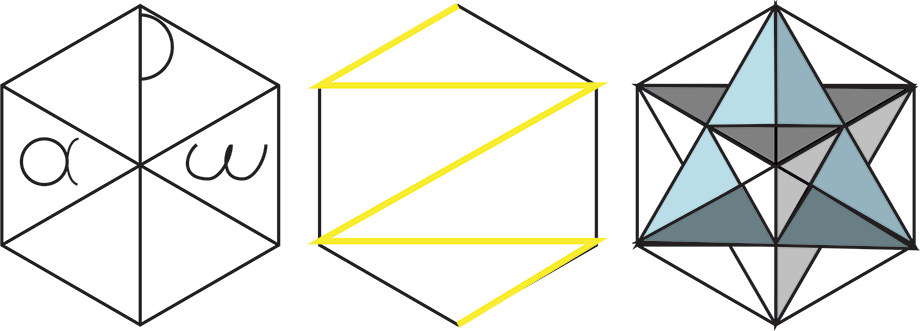
The merkaba is the three dimensional extension of As Above, So Below. It is the two triangles, expressed as interlocking three-faced pyramids (see there was a reason I talked about the platonic pyramid) such that each face of each pyramid is pierced by the the point of another one. The diagram here is derived from the hexagon. I have mocked up one in Lightwave 3-D to show how interesting this thing becomes as an object. Pretty nifty trick for an old Hebrew chariot I think.
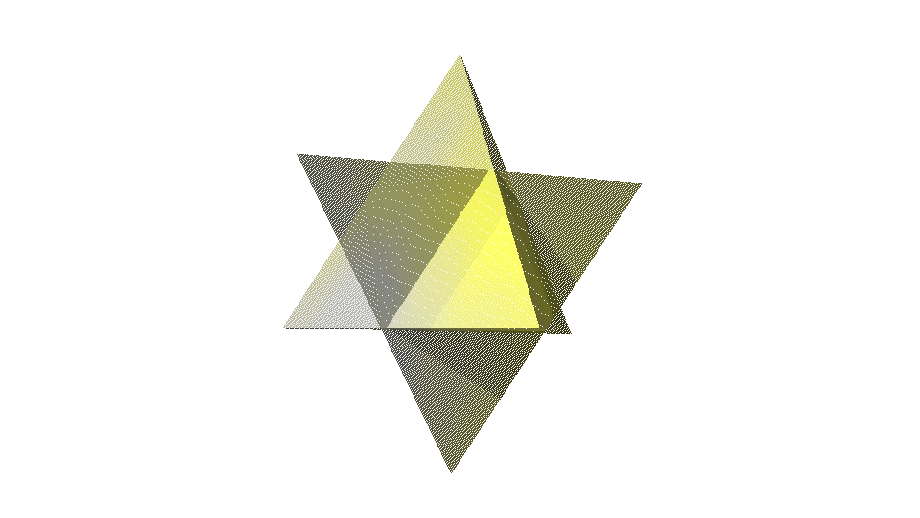
Some also say the word merkaba is derived from the ancient Egyptian root words mer-ka-ba. Several online sources style this as “light, spirit, and body” or “love, spirit, body”, It may be more accurately translated “Pyramid of the Soul and the Shadow” or “Food of the Blessed Dead” since “mer” can be either pyramid or cake. The Greek “pyramid” derives from “pyramis” -wheat cake. The Egyptian wheat cake was called ben-ben, which is the word for the top of the pyramid or the obelisk, which had a similar shape. These shapes were also symbolic of the sun’s rays, and the primordial mound of earth rising from the flood of the celestial Nile where the Lotus that Ra emerges from grew. Mer, then, is not the cake, but the ritual use of the cake, either in feeding a god or a deceased relative, both rituals we know of. It’s not fair to say the Greeks got it wrong, because over the long age of Egypt mer came to mean “love” and “pyramid” as well as the ritual use of the cake.
Those are fascinating concepts to explore. Relating them onward to a Hebrew chariot that is visually complex and symbolically loaded, draws to my mind some of the Old Testament angels connected with the prophet Ezekiel. Plenty of places to go with this one if one is interested.
Speaking of going, in my own explorations, I have used the hexagon/hexagram as basis to develop this symbol, which I will eventually put on an amulet or an altar stone. To my mind it connects with symbols of Hekate, and well, Hekate, Heka, Hex, Haxxan, Hagatesse and Hexagon can all blur lines in rhyme, alliteration, and the verbal games we play in spell work. And now you can see that there are mathematical and geometric games you can play as well, so if you are looking for right angle (pun meaningfully intended) to approach a particular magical operation, I hope I have given you some new tools to work with. If nothing else, I hope it encourages you to spend time looking past the surface of things as presented.
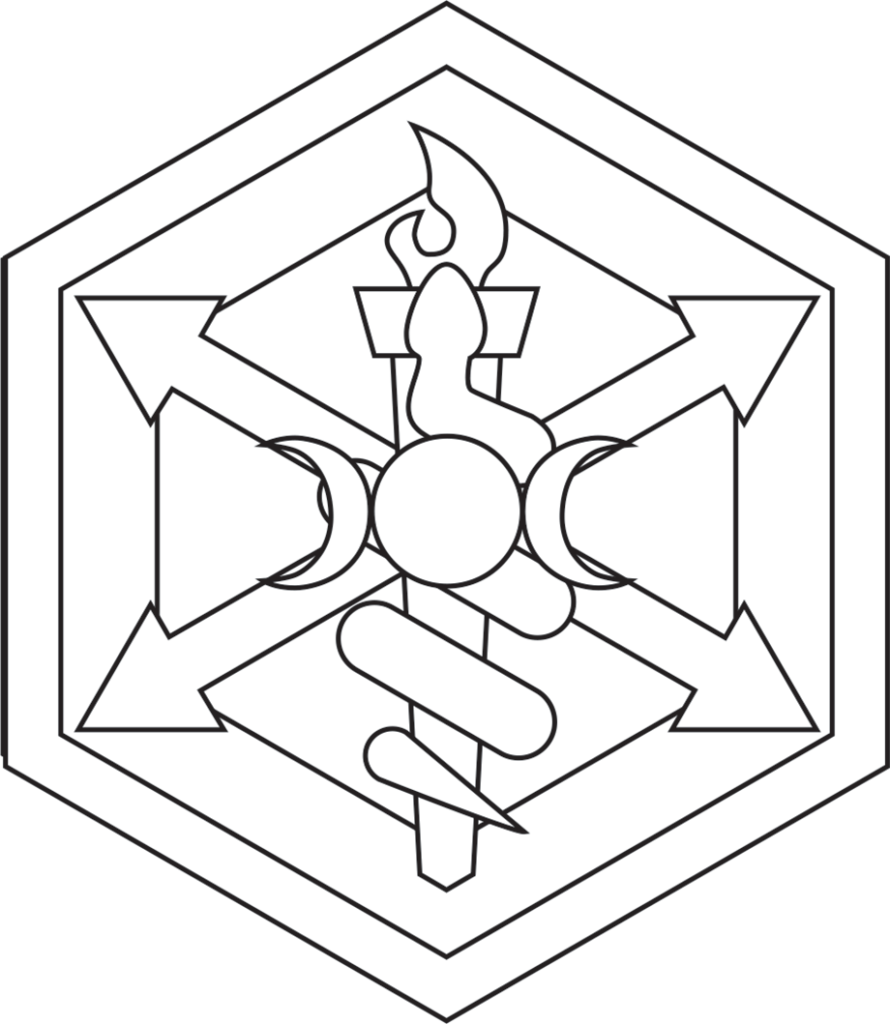
Before departing this week’s article I fully admit to lifting the title from a very much more important work. Even though you can’t copyright titles, and the words fit my little exercise, equally well, I clearly acknowledge, respect and admire the work of the pioneering African-American women the book and film Hidden Figures is about. Their contribution to the advancement of both the space program, and cause of racial justice in this country, cannot be minimized. If you are unaware of it, I strongly encourage you make yourself familiar.
Thank you again for reading all the way to the end of this week’s piece. It is longer and potentially more complicated that what I have offered in the past. More like this is forthcoming, so I hope you find it useful. I’ll be back again in a week.


By virtue of the Hex! Hagtastical! I love the way you wove such powerful & numerical symbols all together for this installment + the design of your own Sigil. Thank you 🔥👁️🔮
As always I appreciate your responses. This is just one of those rabbit holes my mind goes down from time to time (okay, most of the time). After I posted, I found an image online where someone had used the hexagon to construct multiple pentagons, which then of course, could contain pentagrams, so apparently those magical constructs are hidden in there as well.
You might also find interesting an old H.P. Lovecraft story called “The Dreams in the Witch House” which explores the connection between magic and geometry and mathematics.
As for the sigil, I had an idea that I might actually produce some of these as altar tiles for sale at one point. I may yet.
Thank you again for reading and spreading the word.